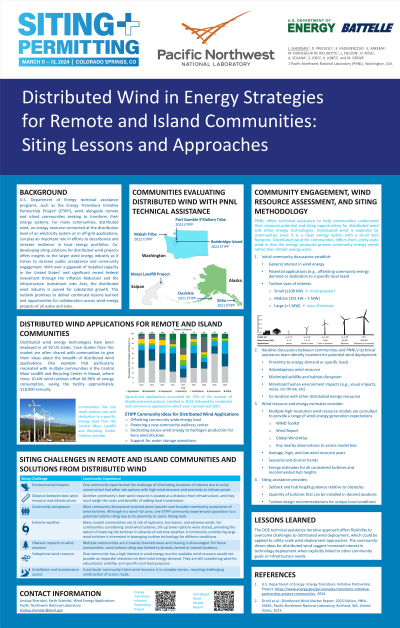Back

Multi-tech
Siting Guidelines: Challenges, Opportunities, and Case Studies of Success
The Role of Distributed Wind in Energy Strategies for Remote and Island Communities
Tuesday, March 12, 2024
5:00 PM – 6:00 PM MT


Lindsay Sheridan
Earth Scientist
Pacific Northwest National Laboratory, Washington
Presenter(s)
Presentation Description: The U.S. Department of Energy’s Energy Transitions Initiative Partnership Project (ETIPP) works alongside remote and island communities seeking to transform their energy systems. For many communities, distributed wind, an energy resource connected at the distribution level of an electricity system or in off-grid applications, can play an important role in their efforts to decarbonize and increase resilience in their energy portfolios. With significant recent federal investment, the distributed wind industry is poised for substantial growth.
ETIPP communities have shown enthusiasm for distributed wind projects of all scales, mirroring the range of distributed wind projects installed nationwide over the past two decades. Some communities are only considering small wind (≤100 kW) due to environmental or aesthetic concerns, while others are interested in deploying large multi-megawatt turbines with a vision of dedicating extra wind generation to produce hydrogen. Major siting considerations include wildlife impacts, proximity to recreation trails, distance between advantageous wind areas and locations of energy demand, and extreme weather exposure.
Multiple years of ETIPP partnerships have revealed diverse energy needs and desires of remote and island communities. This work places those local goals within the larger context of the distributed wind market to discuss the interests in, perceptions of, and applications for distributed wind for ETIPP communities with a focus on siting-related plans and challenges. Additionally, this work shares the workflow for community engagement concerning distributed wind and evaluation of whether it is a viable resource for meeting each community’s energy goals.
ETIPP communities have shown enthusiasm for distributed wind projects of all scales, mirroring the range of distributed wind projects installed nationwide over the past two decades. Some communities are only considering small wind (≤100 kW) due to environmental or aesthetic concerns, while others are interested in deploying large multi-megawatt turbines with a vision of dedicating extra wind generation to produce hydrogen. Major siting considerations include wildlife impacts, proximity to recreation trails, distance between advantageous wind areas and locations of energy demand, and extreme weather exposure.
Multiple years of ETIPP partnerships have revealed diverse energy needs and desires of remote and island communities. This work places those local goals within the larger context of the distributed wind market to discuss the interests in, perceptions of, and applications for distributed wind for ETIPP communities with a focus on siting-related plans and challenges. Additionally, this work shares the workflow for community engagement concerning distributed wind and evaluation of whether it is a viable resource for meeting each community’s energy goals.
